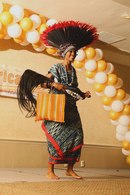There is a so much I can tell you all about my home country of Cameroon in terms of Fashion and Culture but I will stick with the Fashion for now because the Culture is one hell of a thing especially when you have 10 province and more than 100 cultures in one country. Fashion in Cameroon is different depending on the person but they are common nouns that are on every Cameroonian’s lips from the coast to the mainland, even the diaspora whether male or female, old or young and even I may say babies. I will tell you the various:
Kabba: What is a Kabba you may ask? Kabba is a one piece flowing dress sometimes similar to what the Western fashion will call maxi dress worn by women. Cameroonian ladies bring it to various tailors to be seam from neck/shoulders area to legs or either lower or higher. Mostly worn at all times during the day or at night, and during events or choir practice. Prefect for free flow, comfort.

Boubou or Also Known as Agbada: Worn by men and originally from the Northern Cameroon, It is also a free flowing garment made of 4 parts the inner garment, the outerwear with large pockets, pants and a head cap.
Foulard or Head scarves: Sown from the rest of your material mostly tied by women and young girls to protect your head.
Pagnes (Sarongs aka San-njea , aka Wrapper) Pagnes is a traditional clothing worn by Cameroonian and is consistently different from tribes to tribes
Gant: Gant is a heavy material worn by women and men. This is one of the most delicate material found in West and Central Africa.
Chechia a traditional hat worn by men and women in villages on special occasions
Kwa Cameroon cultural male handbag and can be seen around in Villages
Gandura cameroonian male custom attire
Tribal Dress:
South West Cameroon:
North West Cameroon: The toghu worn also bu the Bamileke and those from the North West.
Littoral Cameroon: Douala is the town to be in when in this province. Where I spent 8 years of my life I will say I am very much a native of this province but with roots in Bamileke land. In this province women were a lot of Kabba or what is also known as “Kaba Ngondo”. Depending on where you are from or in men will wear tshirts/shirts have a cloth tied around their waist and a head scarf
Centre and South Cameroon: Where our capital city and the land I grew up for 8 years is situated Yaounde also known as the political capital and the South capital Ebolowa. With tribes like the Beti, Ewondo, Bulu and Fangs.
An Ewondo woman
Northern, Adamawa and Extreme North Cameroon: With capital Garoua and Maroua respectively, tribes in this region are the Fulani, Tikar, Hausas, and the Mbororos.
West Cameroon (Bamileke and Bamoun): My pride and joy. Am proud to be Cameroonian but proudest to be a Bamileke there is nothing more to add to this. We are found in West Cameroon. With capital Bafoussam, 2 tribes can be found here the Bamileke and Bamoun.








































Pingback: Reconstructing what’s lost | fynm
Pingback: Analogues | fynm
Pingback: Speaking of sartorial survival | fynm
How do I learn more??
LikeLike
Thank you for writing this blog post! I’m hoping to learn about the history of kabba ngondo. Would you be willing to talk to me about its history, the defining features of kabba ngondo, and potential resources to read more?
LikeLike